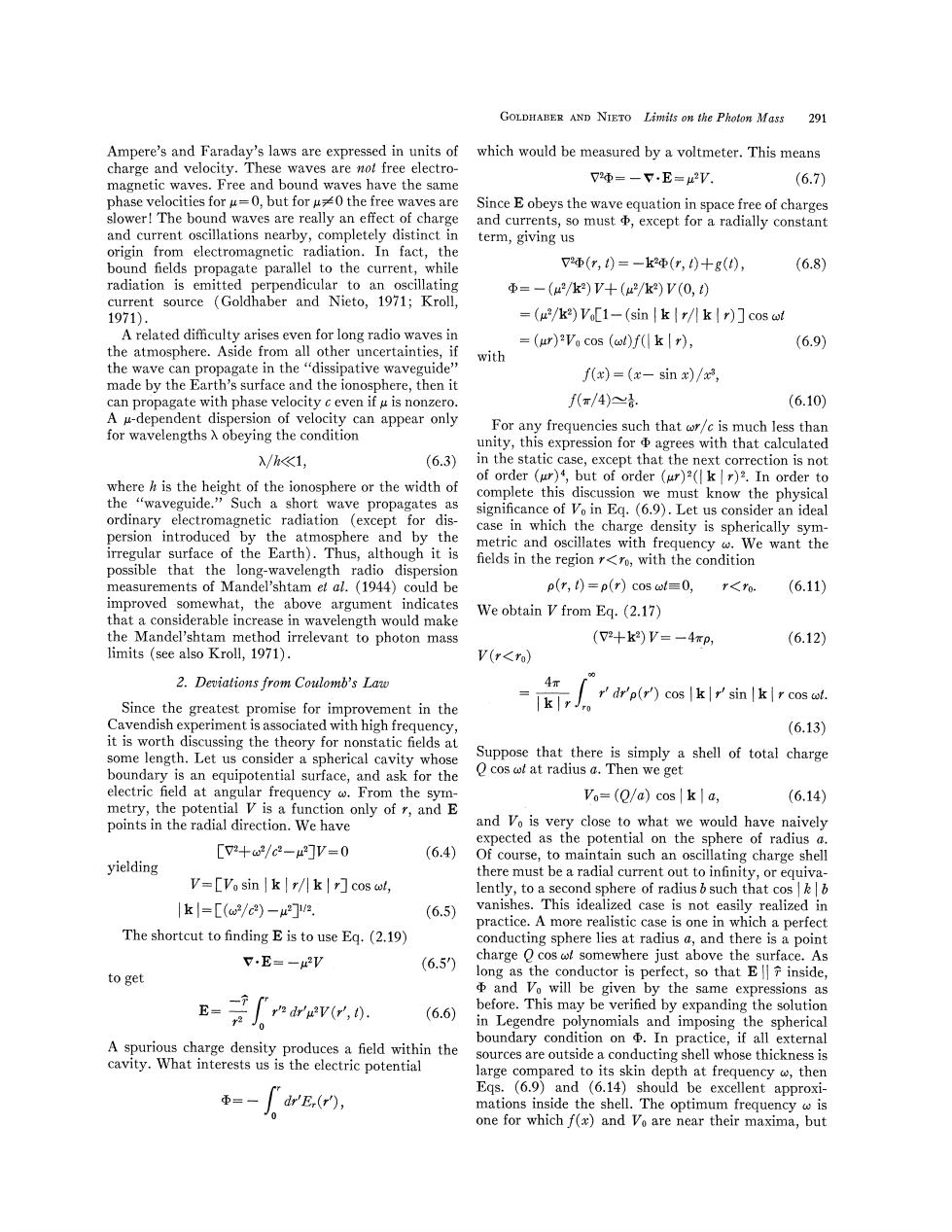正在加载图片...

GOLDHABER AND NIETO Limits on the Photon Mass 291 Ampere's and Faraday's laws are expressed in units of which would be measured by a voltmeter.This means charge and velocity.These waves are not free electro- magnetic waves.Free and bound waves have the same 72Φ=一又.E=u2V (6.7) phase velocities for u=0,but for u0 the free waves are Since E obeys the wave equation in space free of charges slower!The bound waves are really an effect of charge and currents,so must except for a radially constant and current oscillations nearby,completely distinct in term,giving us origin from electromagnetic radiation.In fact,the bound fields propagate parallel to the current,while 7④(7,)=-k2Φ(1,)+g(), (6.8) radiation is emitted perpendicular to an oscillating Φ=-(u2/k2)V+(u2/k2)V(0,t) current source (Goldhaber and Nieto,1971;Kroll, 1971). =(u2/k2)Vo[1-(sin kr/kr)]cos at A related difficulty arises even for long radio waves in =(ur)2Vo cos (ot)f(kr), (6.9) the atmosphere.Aside from all other uncertainties,if with the wave can propagate in the "dissipative waveguide" f(x)=(x-sin x)/, made by the Earth's surface and the ionosphere,then it can propagate with phase velocity c even if u is nonzero. f(r/4)≈合. (6.10) A u-dependent dispersion of velocity can appear only for wavelengths A obeying the condition For any frequencies such that wr/c is much less than unity,this expression for agrees with that calculated λ/h<K1, (6.3) in the static case,except that the next correction is not of order (ur)4,but of order (ur)3(k r)2.In order to where h is the height of the ionosphere or the width of the "waveguide."Such a short wave propagates as complete this discussion we must know the physical significance of Vo in Eq.(6.9).Let us consider an ideal ordinary electromagnetic radiation (except for dis- persion introduced by the atmosphere and by the case in which the charge density is spherically sym- metric and oscillates with frequency w.We want the irregular surface of the Earth).Thus,although it is possible that the long-wavelength radio dispersion fields in the region r<ro,with the condition measurements of Mandel'shtam et al.(1944)could be p(r,t)=p(r)cos wt=0,r<ro. (6.11) improved somewhat,the above argument indicates that a considerable increase in wavelength would make We obtain V from Eq.(2.17) the Mandel'shtam method irrelevant to photon mass (T2+k2)V=-4wp, (6.12) limits (see also Kroll,1971). V(r<ro) 2.Deviations from Coulomb's Law 4π r'dr'p(r')cos kr'sin k r cos ot. Since the greatest promise for improvement in the Cavendish experiment is associated with high frequency, (6.13) it is worth discussing the theory for nonstatic fields at some length.Let us consider a spherical cavity whose Suppose that there is simply a shell of total charge boundary is an equipotential surface,and ask for the O cos wt at radius a.Then we get electric field at angular frequency w.From the symn- Vo=(Q/a)cos|kl a, (6.14) metry,the potential V is a function only of r,and E points in the radial direction.We have and Vo is very close to what we would have naively expected as the potential on the sphere of radius a. [72+w2/c2-u2]V=0 (6.4) Of course,to maintain such an oscillating charge shell yielding there must be a radial current out to infinity,or equiva- V=[Vo sin kr/k r]cos wt, lently,to a second sphere of radius b such that coskb |k=[(w2/c2)-a2]a. (6.5) vanishes.This idealized case is not easily realized in practice.A more realistic case is one in which a perfect The shortcut to finding E is to use Eq.(2.19) conducting sphere lies at radius a,and there is a point 7.E=-2V (6.5) charge O cos ol somewhere just above the surface.As to get long as the conductor is perfect,so that E inside, and Vo will be given by the same expressions as E= r dr'uv(r',t) (6.6 before.This may be verified by expanding the solution in Legendre polynomials and imposing the spherical A spurious charge density produces a field within the boundary condition on In practice,if all external cavity.What interests us is the electric potential sources are outside a conducting shell whose thickness is large compared to its skin depth at frequency then Egs.(6.9)and (6.14)should be excellent approxi- Φ=一 dr'E,(r'), mations inside the shell.The optimum frequency is one for which f(x)and Vo are near their maxima,but